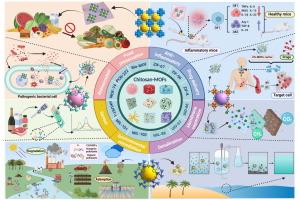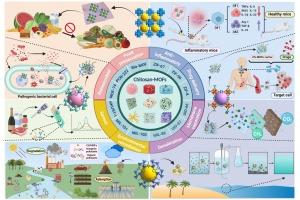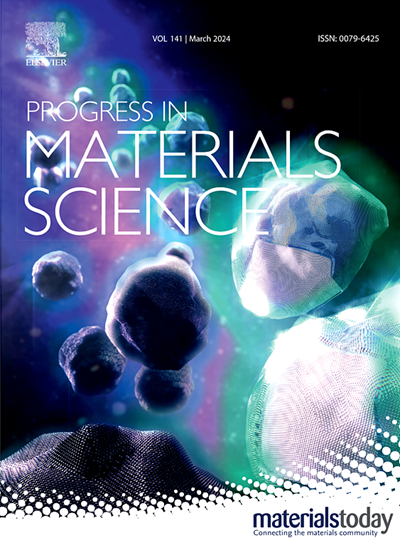Exploring the synthesis, properties, and potential of chitosan-functionalized metal-organic frameworks in emerging applications
IF 40
1区 材料科学
Q1 MATERIALS SCIENCE, MULTIDISCIPLINARY
引用次数: 0
Abstract
Chitosan (CS), a natural cationic biopolymer derived from chitin, has emerged as a promising component for synthesizing biological/bioinspired metal–organic frameworks (BioMOFs). CS’s biodegradability, low toxicity, mucoadhesive properties, and biocompatibility due to its amino and hydroxyl groups make it ideal for developing BioMOFs with applications in biomedicine, catalysis, sensing, food and environmental remediation. CS-based MOFs combine the structural diversity and tunability of MOFs (metal ions and organic linkers) with CS’s inherent advantages, expanding the possibilities for designing functional materials with tailored properties. Incorporating CS into MOF synthesis modulates surface chemistry, pore size, structure, stability, and biocompatibility, making BioMOFs suitable for various biomedical applications (therapeutics, stimuli-responsive drug delivery, antibacterial, anti-inflammatory, wound healing, antidiabetic, and anticancer), food technology (preservation, coating and packaging), and environmental remediation (dye, antibiotic, pesticide removal as sorbents and photocatalysts). This review explores the preparation, properties, and applications of biopolymer CS-based MOFs, which have not been comprehensively summarized in previous reviews. We discuss the potential applications of BioMOFs in biomedicine, environmental remediation, and other fields, highlighting their versatility and potential impact. By comprehensively analyzing recent advancements and challenges in CS-based MOFs, this review aims to provide insights into future directions and opportunities for leveraging CS’s unique properties in MOF design and applications.


探索壳聚糖功能化金属有机框架的合成、特性及其在新兴应用领域的潜力
壳聚糖(CS)是一种天然阳离子生物聚合物,已成为合成生物/生物启发金属有机框架(BioMOFs)的理想成分。CS 易于获取、可生物降解、毒性低、具有粘液粘附性,而且其氨基和羟基具有生物相容性,因此非常适合开发生物有机框架,应用于生物医学、催化、传感和环境修复等领域。基于希尔思的 MOF 将 MOF 的结构多样性和可调性(金属离子和有机连接体)与希尔思的固有优势相结合,为设计具有定制特性的功能材料提供了更多可能性。在 MOF 合成中加入 CS 可调节表面化学性质、孔径、结构、稳定性和生物相容性,从而使 BioMOFs 适合于各种生物医学应用(治疗、刺激响应式给药、抗菌、消炎、伤口愈合、抗糖尿病和抗癌)、食品技术(保鲜和包装)和环境修复(作为吸附剂和光催化剂去除染料、抗生素和农药)。本综述探讨了基于生物聚合物 CS 的 MOFs 的制备、特性和应用,以往的综述尚未对其进行全面总结。我们讨论了 BioMOFs 在生物医学、环境修复和其他领域的潜在应用,强调了它们的多功能性和潜在影响。本综述全面分析了基于希尔思的 MOFs 的最新进展和挑战,旨在为利用希尔思的独特性质进行 MOF 设计和应用的未来方向和机遇提供见解。
本文章由计算机程序翻译,如有差异,请以英文原文为准。
求助全文
约1分钟内获得全文
求助全文
来源期刊

Progress in Materials Science
工程技术-材料科学:综合
CiteScore
59.60
自引率
0.80%
发文量
101
审稿时长
11.4 months
期刊介绍:
Progress in Materials Science is a journal that publishes authoritative and critical reviews of recent advances in the science of materials. The focus of the journal is on the fundamental aspects of materials science, particularly those concerning microstructure and nanostructure and their relationship to properties. Emphasis is also placed on the thermodynamics, kinetics, mechanisms, and modeling of processes within materials, as well as the understanding of material properties in engineering and other applications.
The journal welcomes reviews from authors who are active leaders in the field of materials science and have a strong scientific track record. Materials of interest include metallic, ceramic, polymeric, biological, medical, and composite materials in all forms.
Manuscripts submitted to Progress in Materials Science are generally longer than those found in other research journals. While the focus is on invited reviews, interested authors may submit a proposal for consideration. Non-invited manuscripts are required to be preceded by the submission of a proposal. Authors publishing in Progress in Materials Science have the option to publish their research via subscription or open access. Open access publication requires the author or research funder to meet a publication fee (APC).
Abstracting and indexing services for Progress in Materials Science include Current Contents, Science Citation Index Expanded, Materials Science Citation Index, Chemical Abstracts, Engineering Index, INSPEC, and Scopus.
 求助内容:
求助内容: 应助结果提醒方式:
应助结果提醒方式:


